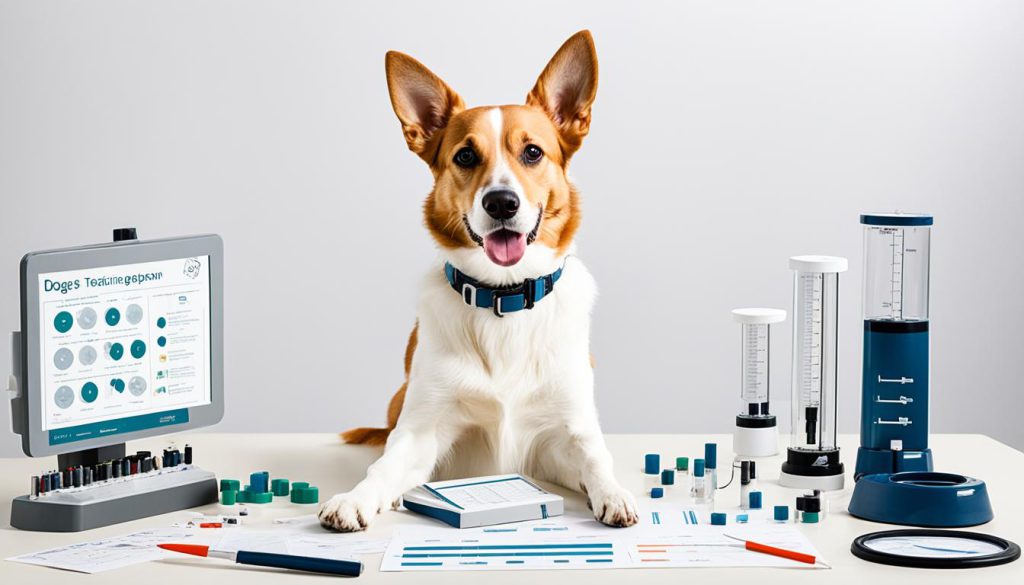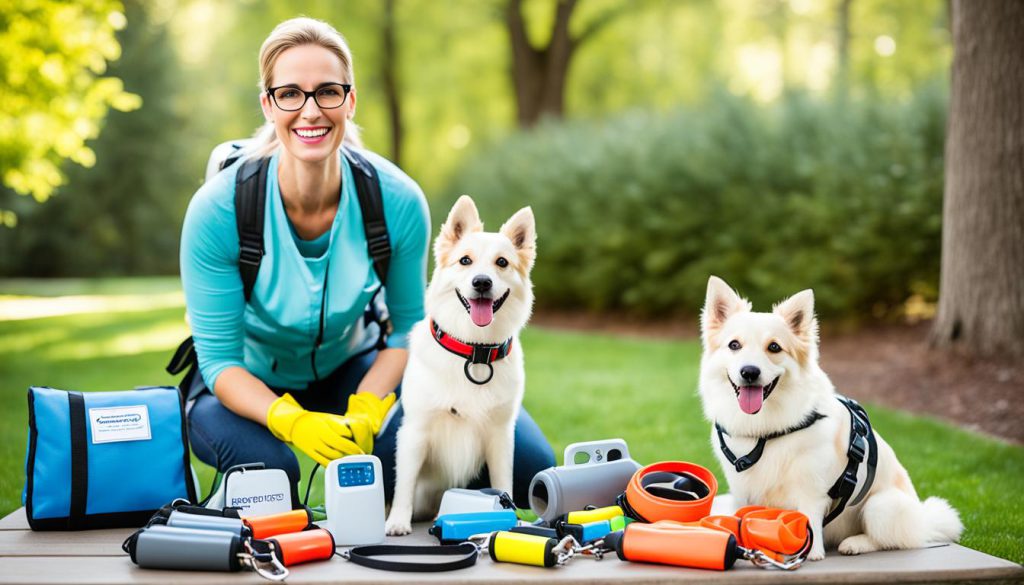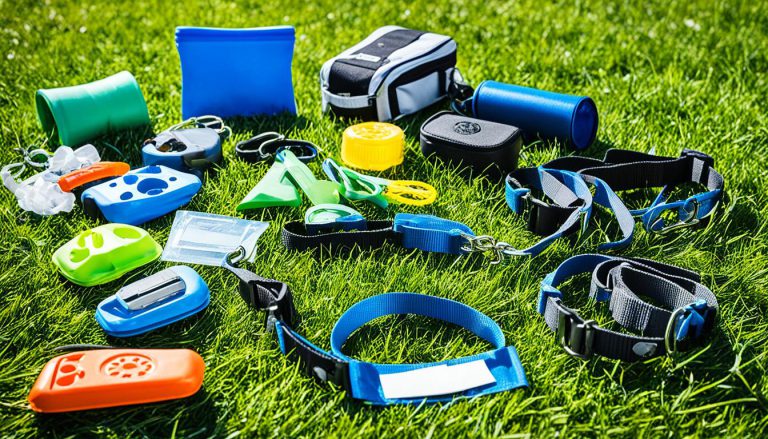Ever wonder why some dogs listen well and others don’t? The answer often involves dog training aids. A new study with 10 military and 20 police dogs is testing these aids. They are looking at how different tools impact training. Tools like electronic collars, clickers, and leashes vary widely. Yet, they all strive to help achieve training goals. Whether it’s basic obedience for a pet or advanced training for service, the right equipment is key.
Key Takeaways
- Training aids play a crucial role in improving dog obedience and behavior.
- A range of tools, from e-collars to clickers, offer different benefits for various training objectives.
- Studies have shown mixed results on the effectiveness of aversive versus reward-based methods.
- The selection of training aids should consider the dog’s temperament and the specific training goals.
- Consistent and ethical use of these tools can prevent behavioral problems that often lead to dog relinquishment.
The Importance of Training Aids in Dog Training
Training aids are key in teaching dogs to obey and in managing their behavior.
Understanding the Role of Training Aids
Training aids significantly boost the success of training sessions. They ensure dogs and their trainers understand each other.
For example, halters and harnesses are popular for controlling a dog’s movement. Trainers choose from flat collars, slip chains, or head halters based on their goals.
Benefits of Using Training Aids
- Enhanced Communication: Training aids like clickers and whistles make it easier for dogs to get commands. They are crucial for recall training and more.
- Safety and Control: Collars and leads help trainers manage their dogs on walks. Training collars and long lines teach leash manners, especially to big dogs.
- Behavioral Management: Tools like treat pouches and toys encourage good behavior. Bark control devices help with barking issues.
- Adaptability: There are many training aids to fit any dog’s personality. This includes everything from agility tools to fun toys for physical and mental play.
| Benefit | Training Aid | Application |
|---|---|---|
| Enhanced Communication | Clickers, Whistles | Recall training, command precision |
| Safety and Control | Collars, Leads | Proper leash etiquette, walk control |
| Behavioral Management | Treat Pouches, Bark Control Devices | Motivation and reward, excessive barking control |
| Adaptability | Agility Tools, Interactive Toys | Physical and mental stimulation |
Choosing the right training aids makes them more effective. This helps strengthen the bond between dogs and their owners.
Types of Dog Training Aids
Dog training aids are key for good training sessions. Each aid has its own advantages. They meet the specific needs of a dog’s training.
Electronic Collars (E-collars)
Electronic collars give quick feedback to dogs. This is vital for fixing bad behaviors fast. They come in models like static, vibration, and tone. E-collars are great for training dogs off-leash.
Clicker Training
Clicker training is a method that rewards good behavior. It uses a sound to mark the right actions. Along with treats, this method makes it easy for dogs to learn and repeat good behaviors. The clickers sold in the shop are supported by treat bags and toys that make training fun.
Leashes and Harnesses
Leashes and harnesses are important for control and correction. Our shop has leashes from 5 to 15 meters long, perfect for recall training. Our harnesses, like the Chest Plate and front attaching harness, offer comfortable control. They work well for everyday walks and serious training.
Bark Control Devices
Bark control devices cut down on loud barking. These aids adjust a dog’s barking habits with different stimuli. This leads to a calmer and quieter home.
Choosing the Right Training Aid for Your Dog
Picking the right training aid is key for your dog’s learning. It’s about finding what works best with their personality and your training goals. Different tools work better for different dogs. The right tool can make teaching your dog much easier.
Considering Your Dog’s Temperament
Start by understanding your dog’s nature. Dogs react differently to various training tools. Some dogs do well with positive reinforcement like clickers and treats. Yet, others might need structured tools like harnesses or head halters. These help manage pulling and maintain control during walks.
Matching Training Aids to Training Goals
It’s important to match training aids to what you want to achieve. For teaching basic commands or changing behavior, collars and leads are great. They help you keep control and guide your dog. But, if you want to challenge your dog’s brain, try puzzle feeders.
When aiming to stop your dog from pulling, harnesses can be a good choice. They spread the pulling force across the dog’s body. This makes walks more comfortable and under control.
Choosing the right training tool also means picking high-quality items. Even though they may cost more, they last longer. Getting advice from pros like behaviorists and trainers is also smart. They can help you find the best tools for your dog.
Electronic Training Aids: Pros and Cons
Electronic training devices are big in dog training for their accuracy and reliability. But, it’s vital to look at their advantages and disadvantages. This helps make sure they’re used correctly.

Benefits of Electronic Training Aids
The perks of e-collars are many. Fans point out they allow for better control and quick feedback. This fast response helps reinforce good behavior. In busy or distracting places, these devices prove very helpful. As noted by Zoom, people keep 95% of what they learn through interactive methods like video. This idea also applies to dogs, who react well to instant and regular signals.
- Precise Timing: The immediate correction from electronic devices can sharply link behavior with its results. This supports quicker learning.
- Wide Range of Application: E-collars fit a range of training scenarios, from simple pet obedience to complex tasks for working dogs.
Drawbacks of Electronic Training Aids
Even with the upsides of e-collars, there are downsides to consider. Using them wrongly can harm a dog’s behavior or weaken the pet-owner bond. Research gives mixed findings on how they affect a dog’s wellbeing. Studies have explored the long-lasting impacts of these training aids.
- Potential Welfare Risks: Misuse can cause stress or harm to the dog. A 2007 study pointed out possible dangers from electric collars.
- Controversy and Regulation: The debate and rules about e-collars grow as concerns for animal welfare increase.
As dog training tech gets better, it’s crucial to know how to use electronic devices wisely. Using them right, considering each dog’s needs, is essential. This ensures training is effective and kind, balancing benefits against risks.
Positive Reinforcement Training Aids
Positive reinforcement uses rewards to encourage good behavior in dogs. This method helps dogs repeat these behaviors. It also makes the connection stronger between the dog and the owner.
Clickers
Clicker training quickly shows dogs what is right. A clicker makes a sound to mark when a dog does something good. This quick and clear feedback helps dogs learn faster and keeps up their good behavior.
Treats and Toys
Dog treats are key in positive reinforcement. They make dogs happy right away, so dogs want to do well again. But, picking healthy treats is important for the dog’s health.
Training toys also matter in keeping dogs focused. Toys can make training fun by keeping dogs’ minds active. This makes learning better and more fun.
Verbal Commands
Words of praise work alongside tools like clickers and treats. They offer instant approval. Using positive words often helps dogs connect the words to what they did, making training richer and supporting good habits.
Mixed Method Training Aids
Mixed training methods combine reward-based training and aversive techniques. This approach is used in military and police work. It aims for a comprehensive training style.
Combining Reward and Aversive Techniques
Reward-based training and aversive methods are combined here. Rewards encourage good behavior. Aversive techniques correct undesired behaviors. This method achieves quick and effective results in training.
Effectiveness and Efficiency of Mixed Methods
Health science research shows more diverse methods. This includes studying training effectiveness. Many NIH-funded studies focus on mixed training methods. They aim for balanced and effective outcomes in dog training.
However, mixed training methods bring debate about dog welfare. Critics say aversive techniques can harm a dog’s well-being. It’s crucial to balance effectiveness with the dog’s welfare.
Training Aids for Specific Dog Breeds
Different dog breeds need special training aids. If you have a working dog, they need tough tools. Companion dogs benefit from nurturing strategies. The right equipment is key.
Tailoring Training Aids for Working Dogs
Working dogs do important jobs like law enforcement and rescue missions. They need strong and reliable equipment. The working dog equipment includes things like advanced training collars. For example, the 1900S HANDSFREE PLUS B&L training collar costs $279.99. It’s well-rated and perfect for precise control.
These dogs do well with breed-specific training aids made for their tough jobs. For attack training, a Leather Canine Harness for $84.99 is a good pick. A Nylon Dog Harness for $30.99 is great for pulling and tracking.
Adjusting Aids for Companion Dogs
Companion dogs need tools that help with bonding. Companion dog tools focus on good behavior and comfort. A handcrafted leather leash for $27.99 or sensory toys make training fun. The CUE GEN2 collar, at $189.99, is gentle and good for homes.
Using custom training strategies is best for companion animals. Tailored aids help build a strong bond based on mutual respect. It makes training stress-free and effective.
| Product | Description | Price | Rating |
|---|---|---|---|
| CUE GEN2 GREY training collar | Ideal for home training | $189.99 | None |
| CUE GREEN training collar | Affordable, gentle correction | $149.99 | None |
| Tom Davis Edition 280C B&L training collar | High-end professional use | $239.99 | None |
| 1900S HANDSFREE PLUS B&L collar | Highly rated for working dogs | $279.99 | 5/5 from 7 reviews |
| ARC HANDSFREE PLUS B&L collar | Slim design, versatile | $269.99 | 4.7/5 from 6 reviews |
The Science Behind Training Aids
It’s key to understand the science behind training aids to develop effective strategies. We’ll look at aversive methods, reward-based methods, and combined methods. This helps guide our dog training practices.

Studies on Aversive Methods
Aversive methods involve discomfort or negative stimuli. Recent aversive methods studies show the downsides. They can quickly get a response, but may harm the dog’s behavior and well-being.
For example, dogs trained with aversive methods might get more stressed or even aggressive. This raises concerns about such techniques.
Research on Reward-Based Methods
Reward-based training research shows the benefits of using treats, toys, and praise. Such methods not only improve the learning experience but also build a bond between the dog and trainer. Rewards help dogs repeat good behaviors, avoiding the bad effects of aversive methods.
Combined Method Studies
Mixing methods brings complex insights. Some research says using both aversive and reward-based methods can work in certain situations. But, it might confuse and stress the dog.
Experts suggest a balanced approach, carefully using methods to keep dogs happy and healthy during training.
| Training Aid | Aversive Method | Reward-Based Method |
|---|---|---|
| Effect on Dog | Can increase stress and anxiety | Enhances learning and bond |
| Training Outcomes | Quick but potentially harmful | Positive and long-lasting |
| Scientific Support | Mixed and contentious | Strong and consistent |
The latest training methodology research highlights the need to update our training methods. By using science-backed approaches, we’ll not only see better results but also ensure our dogs’ happiness and health.
How to Use Training Aids Effectively
Using training aids the right way begins with knowing about timing and consistency. When training dogs, it’s key to see how these aspects are important. They have a big impact on a dog’s learning. If you’re new to dog training, using aids correctly can make training go more smoothly.
Proper Timing and Consistency
Timing is very important in using training aids right. Reward or correct your dog right when they do something. For example, if you’re using a clicker, click it right when your dog does what you want. Being consistent is just as important. Dogs like routine and doing things over and over. Using commands, cues, and rewards the same way every time helps dogs learn better.
Training Tips for Beginners
For new trainers, it’s key to get good at timing and consistency. Begin with easy commands like “sit,” “stay,” and “come.” You can use pictures or diagrams to help, which can really hold your dog’s attention. Using pictures and sounds together can help your dog remember up to 70% more.
- Using a clicker alongside verbal commands can be highly effective.
- Incorporate treats and toys to keep the dog motivated and engaged.
- Resource packs and handbooks can provide structured material to follow.
- Use overhead projectors or presentation software like PowerPoint for structured training classes.
Here’s a table that shows different visual aids and how good they are for dog training:
| Visual Aid | Effectiveness | Usage |
|---|---|---|
| Photographic Slides | High | Specialized Topics |
| Overhead Projectors | Very High | Customization and Flexibility |
| PowerPoint Presentations | High | Interactive and Engaging |
| Videos/DVDs | Very High | Interactive and Real-Life Examples |
Following these tips and using the resources you have can make you a better trainer. Whether you’re just starting or improving your methods, knowing how to use training aids is key. It’s a big part of teaching dogs successfully.
Safety Considerations with Training Aids
It’s crucial to keep your dog safe while using training aids. Following safe training practices not only makes the aids more effective. It also looks after your dog’s physical and mental well-being. Let’s talk about how to steer clear of dangers and focus on responsible training.
Avoiding Potential Dangers
The first step to training aid safety is knowing your tools well. Using training aids the wrong way can harm your dog. For example, electronic collars can cause distress if not used right. So, it’s key to stick to the guidelines provided and get advice from pros when needed.
Start by slowly introducing any new aid to see how your dog reacts. This approach lets you tweak your training as you observe your dog’s comfort level. It helps avoid your dog getting scared or anxious from new training steps.
Ensuring the Welfare of Your Dog
For your dog’s well-being, choose training aids that are kind. Clickers, treats, and verbal praise are positive reinforcement tools. They help in training and strengthen your bond with your dog.

It’s also smart to regularly review your training plan to ensure it still suits your dog. Being committed to responsible dog training means watching out for signs of stress in your dog. If you see them, you should change your training plan.
| Measure | Purpose | Outcome |
|---|---|---|
| Understanding the Training Aid | Ensures proper usage | Minimized risk of harm |
| Gradual Introduction | Monitors dog’s reaction | Comfort and adaptability |
| Periodic Reassessment | Adjusts to dog’s needs | Ongoing welfare and effectiveness |
By valuing training aid safety, you’re making a supportive and successful training space. This ensures your dog is safe and happy throughout their training journey.
Training Aids
Choosing the right pet training gear is key in the dog training world. Today’s devices are designed for every training from obedience to agility. They are advanced and cater to various needs.
Pet owners and trainers count on professional dog training tools. These tools help with precision, changing behaviors, and keeping performance consistent.
Looking at the new modern training devices, there’s a big move to kinder methods. These devices don’t just help with training. They also make sure dogs are treated well, fitting today’s training ideas.
By integrating these advanced tools into training routines, pet owners can create a more engaging and effective learning environment for their dogs, leading to sustained positive behaviors.
Dog training aids vary from clicker training to advanced electronic collars. No matter the training goal, the right pet training gear is crucial for success. It makes a big difference in meeting training goals.
Conclusion
In wrapping up this detailed review on dog training, it’s clear how crucial choosing the right training aids is. There’s a wide array of aids, from electronic collars to clickers, to suit different needs. Such tools not only make training easier but also help dogs understand their trainers better, leading to better training results.
It’s key to use methods that are based on evidence to reach our goals while keeping the dog’s well-being in mind. Reward-based methods are often seen as more effective and kinder than others, as many experts and studies confirm. As technology evolves, it’s important for trainers to stay open to new aids that fit with up-to-date training ideas, making sure they’re using the best tools out there.
Ultimately, the duty is ours to keep up with the changing world of dog training. Being informed and careful with the aids we use is crucial for raising well-behaved and happy dogs. By applying sound advice and using new aids wisely, we can build a positive training space for all dogs. This ensures their well-being and their success in different roles.
Source Links
- https://www.ncbi.nlm.nih.gov/pmc/articles/PMC7895348/
- https://betterpet.com/13-training-tools-for-dogs-and-what-they-do/
- https://www.dogsnsw.org.au/owners/behaviour/training-aids-get-the-right-equipment-and-teach-your-dog-to-use-it
- https://primalneeds.com/dog-training-tools-the-essential-gear-for-effective-training
- https://www.petswhiskers.com/training/training-aids/
- https://ruffacademywi.com/the-essential-guide-to-dog-training-equipment
- https://www.educate-me.co/blog/training-tools-for-employees
- https://thehorse.com/182591/training-aid-fact-and-fiction-for-better-riding/
- https://www.ncbi.nlm.nih.gov/pmc/articles/PMC8109788/
- https://www.thewillingequine.com/post/2017/03/04/long-low-training-aids
- https://www.preventivevet.com/dogs/dog-training-aversives
- https://positively.com/dog-training/article/philosophy-positive-training
- https://obssr.od.nih.gov/sites/obssr/files/Best_Practices_for_Mixed_Methods_Research.pdf
- https://scholarworks.waldenu.edu/cgi/viewcontent.cgi?referer=&httpsredir=1&article=1507&context=dissertations
- https://www.dogtra.com/products/remote-training/obedience
- https://www.fordogtrainers.com/
- https://www.horsejournals.com/riding-training/tack-gear/english/science-tack-and-training-aids
- http://www.ica-sae.org/trainer/english/p17.htm
- https://blogs.shu.ac.uk/hkcindia/files/2016/12/Selecting-your-teaching-aids-India-2016.pdf
- https://apps.dtic.mil/sti/tr/pdf/ADA544611.pdf
- https://www.osha.gov/harwoodgrants/best-practices
- https://www.waywedo.com/blog/equipment-training/
- https://wellputt.com/us/11-training-aids
- https://files.eric.ed.gov/fulltext/ED613989.pdf

